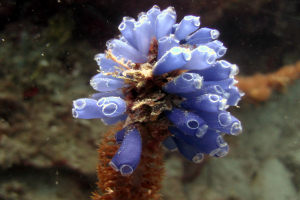Cellulose nanowhiskers from sea squirts aid growth of artificial human muscle
28 March 2011
Nanowhiskers made from cellulose extracted from sea squirts have unique properties that can help grow artificial muscle, University of Manchester researchers have discovered.
The whiskers are several thousand times smaller than muscle cells and are the smallest physical feature found to cause cell alignment. Alignment is important since muscle tissue contains aligned fibres which give it strength and stiffness.
Cellulose is already used in medical applications, including wound dressings, but this is the first time it has been proposed for creating skeletal muscle tissue.

Tunicates (see photo above) grow on rocks and man-made structures in coastal waters around the world. University of Manchester academics Dr Stephen Eichhorn and Dr Julie Gough, working with PhD student James Dugan, chemically extracted the cellulose in the form of nanowhiskers which are 10-15 nanometres diameter.
When aligned by spin coating on a flat surface, the cellulose whiskers cause muscle cells to align and fuse. The method is both simple and relatively quick, which could lead to doctors and scientists having the ability to create the normal aligned architecture of skeletal muscle tissue.
This tissue could be used to help repair existing muscle or even grow muscle from scratch. Creating artificial tissue which can be used to replace damaged or diseased human muscles could revolutionise healthcare, and be of huge benefit to millions of people all over the world.
Dr Eichhorn thinks the cellulose extracted from the creatures could lead to a significant medical advancement. He added: “Although it is quite a detailed chemical process, the potential applications are very interesting.
“Cellulose is being looked at very closely around the world because of its unique properties, and because it is a renewable resource, but this is the first time that it has been used for skeletal muscle tissue engineering applications.
“There is potential for muscle precision engineering, but also for other architecturally aligned structures such as ligaments and nerves.”
PhD student James Dugan has become the first UK student to win the American Chemical Society’s Cellulose and Renewable Material Division award for his work on nanowhiskers.